对外经贸大学:《人力资源管理 Human Resource Management》课程教学资源(作业)Chapter 6 Appraising and Managing Performance

莲喇母矮降贸多大学 人力资源管理 Chapter 6 Appraising and Managing Performance True/False Questions 8-1.Performance management is the method managers use to manage workflow. Ans:F Difficulty:E Page 276 L02 8-2.Through performance management,managers can determine whether or not employees are working to meet organizational goals. Ans:T Difficulty:E Page 276 L02 8-3.Performance feedback is a means for employees to adjust their performance to meet organizational goals. Ans:T Difficulty:E Page 276 L02 8-4.The link between performance management and the organization's strategies and goals is often neglected. Ans:T Difficulty:E 第1页共26页
人力资源管理 Chapter 6 Appraising and Managing Performance True/False Questions 8-1. Performance management is the method managers use to manage workflow. Ans: F Difficulty: E Page 276 LO2 8-2. Through performance management, managers can determine whether or not employees are working to meet organizational goals. Ans: T Difficulty: E Page 276 LO2 8-3. Performance feedback is a means for employees to adjust their performance to meet organizational goals. Ans: T Difficulty: E Page 276 LO2 8-4. The link between performance management and the organization’s strategies and goals is often neglected. Ans: T Difficulty: E 第 1 页 共 26 页

爸剥斗煙降餐多大学 人力资源管理 Page 277 L02 8-5.Performance planning and evaluation systems specify a desired level of performance at the beginning of the evaluation period. Ans:T Difficulty:E Page 278 L02 8-6.Formal performance appraisal systems do not focus on organizational strategy. Ans:F Difficulty:E Page 278 L02 8-7.Organizational culture can inhibit the employee from performing effectively. Ans:T Difficulty:E Page 278 L02 8-8.The extent to which a performance management system seeks performance consistent with organizational goals is referred to as strategic congruence. Ans:T Difficulty:E Page 280 LO3 第2页共26页
人力资源管理 Page 277 LO2 8-5. Performance planning and evaluation systems specify a desired level of performance at the beginning of the evaluation period. Ans: T Difficulty: E Page 278 LO2 8-6. Formal performance appraisal systems do not focus on organizational strategy. Ans: F Difficulty: E Page 278 LO2 8-7. Organizational culture can inhibit the employee from performing effectively. Ans: T Difficulty: E Page 278 LO2 8-8. The extent to which a performance management system seeks performance consistent with organizational goals is referred to as strategic congruence. Ans: T Difficulty: E Page 280 LO3 第 2 页 共 26 页
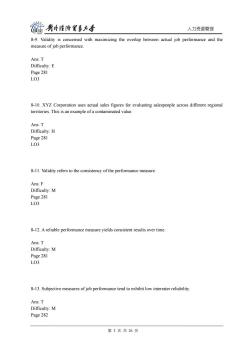
喇牛煙将多大是 人力资源管理 8-9.Validity is concerned with maximizing the overlap between actual job performance and the measure of job performance Ans:T Difficulty:E Page 281 L03 8-10.XYZ Corporation uses actual sales figures for evaluating salespeople across different regional territories.This is an example of a contaminated value. Ans:T Difficulty:H Page 281 LO3 8-11.Validity refers to the consistency of the performance measure. Ans:F Difficulty:M Page 281 LO3 8-12.A reliable performance measure yields consistent results over time. Ans:T Difficulty:M Page 281 LO3 8-13.Subjective measures of job performance tend to exhibit low interrater reliability. Ans:T Difficulty:M Page 282 第3页共26页
人力资源管理 8-9. Validity is concerned with maximizing the overlap between actual job performance and the measure of job performance. Ans: T Difficulty: E Page 281 LO3 8-10. XYZ Corporation uses actual sales figures for evaluating salespeople across different regional territories. This is an example of a contaminated value. Ans: T Difficulty: H Page 281 LO3 8-11. Validity refers to the consistency of the performance measure. Ans: F Difficulty: M Page 281 LO3 8-12. A reliable performance measure yields consistent results over time. Ans: T Difficulty: M Page 281 LO3 8-13. Subjective measures of job performance tend to exhibit low interrater reliability. Ans: T Difficulty: M Page 282 第 3 页 共 26 页

能男牛语降贸多大 人力资源管理 LO3 8-14.Specificity refers to the extent which a performance measure instructs employees about what is expected of them. Ans:T Difficulty:E Page 282 LO3 8-15.In the forced distribution technique,employees are ranked from highest to lowest. Ans:F Difficulty:M Page 284 L04 8-16.In Brito v.Zia,the Supreme Court criticized the subjective nature of graphic rating scales. Ans:T Difficulty:M Page 286 L04 8-17.Attribute-based performance methods are the least popular performance evaluation approaches. Ans:F Difficulty:M Page 287 L04 8-18.The critical incident technique is a behavioral approach to performance management. 第4页共26页
人力资源管理 LO3 8-14. Specificity refers to the extent which a performance measure instructs employees about what is expected of them. Ans: T Difficulty: E Page 282 LO3 8-15. In the forced distribution technique, employees are ranked from highest to lowest. Ans: F Difficulty: M Page 284 LO4 8-16. In Brito v. Zia, the Supreme Court criticized the subjective nature of graphic rating scales. Ans: T Difficulty: M Page 286 LO4 8-17. Attribute-based performance methods are the least popular performance evaluation approaches. Ans: F Difficulty: M Page 287 LO4 8-18. The critical incident technique is a behavioral approach to performance management. 第 4 页 共 26 页
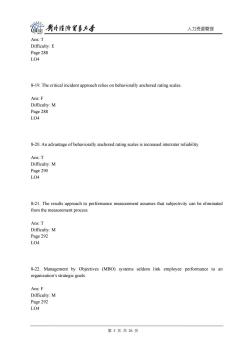
链剥将发多大是 人力资源管理 Ans:T Difficulty:E Page 288 L04 8-19.The critical incident approach relies on behaviorally anchored rating scales. Ans:F Difficulty:M Page 288 L04 8-20.An advantage of behaviorally anchored rating scales is increased interrater reliability. Ans:T Difficulty:M Page 290 L04 8-21.The results approach to performance measurement assumes that subjectivity can be eliminated from the measurement process. Ans:T Difficulty:M Page 292 L04 8-22.Management by Objectives (MBO)systems seldom link employee performance to an organization's strategic goals. Ans:F Difficulty:M Page 292 L04 第5页共26页
人力资源管理 Ans: T Difficulty: E Page 288 LO4 8-19. The critical incident approach relies on behaviorally anchored rating scales. Ans: F Difficulty: M Page 288 LO4 8-20. An advantage of behaviorally anchored rating scales is increased interrater reliability. Ans: T Difficulty: M Page 290 LO4 8-21. The results approach to performance measurement assumes that subjectivity can be eliminated from the measurement process. Ans: T Difficulty: M Page 292 LO4 8-22. Management by Objectives (MBO) systems seldom link employee performance to an organization’s strategic goals. Ans: F Difficulty: M Page 292 LO4 第 5 页 共 26 页

爸剥斗煙降食多大学 人力资源管理 8-23.A disadvantage of the results approach to performance measurement is that individuals may focus only on aspects of their performance that are measured. Ans:T Difficulty:E Page 295 L04 8-24.Supervisors are the most frequently used source of performance information. Ans:T Difficulty:E Page 300 L06 8-25.The best use of self-ratings is for administrative purposes. Ans:F Difficulty:E Page 302 L06 Multiple Choice Questions 8-26.The system that seeks to tie the performance appraisal process to the firm's strategies through specifying at the beginning of the evaluation period what types and levels of performance must be accomplished is called the a.performance appraisal and evaluation system. b.performance feedback system. c.performance management system. d.performance planning and evaluation system. 第6页共26页
人力资源管理 8-23. A disadvantage of the results approach to performance measurement is that individuals may focus only on aspects of their performance that are measured. Ans: T Difficulty: E Page 295 LO4 8-24. Supervisors are the most frequently used source of performance information. Ans: T Difficulty: E Page 300 LO6 8-25. The best use of self-ratings is for administrative purposes. Ans: F Difficulty: E Page 302 LO6 Multiple Choice Questions 8-26. The system that seeks to tie the performance appraisal process to the firm’s strategies through specifying at the beginning of the evaluation period what types and levels of performance must be accomplished is called the a. performance appraisal and evaluation system. b. performance feedback system. c. performance management system. d. performance planning and evaluation system. 第 6 页 共 26 页
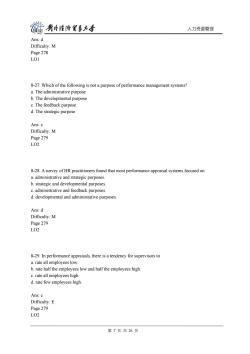
链剥挂将发多大是 人力资源管理 Ans:d Difficulty:M Page 278 L01 8-27.Which of the following is not a purpose of performance management systems? a.The administrative purpose b.The developmental purpose c.The feedback purpose d.The strategic purpose Ans:c Difficulty:M Page 279 L02 8-28.A survey of HR practitioners found that most performance appraisal systems focused on a.administrative and strategic purposes. b.strategic and developmental purposes. c.administrative and feedback purposes d.developmental and administrative purposes. Ans:d Difficulty:M Page 279 L02 8-29.In performance appraisals,there is a tendency for supervisors to a.rate all employees low. b.rate half the employees low and half the employees high. c.rate all employees high. d.rate few employees high Ans:c Difficulty:E Page 279 L02 第7页共26页
人力资源管理 Ans: d Difficulty: M Page 278 LO1 8-27. Which of the following is not a purpose of performance management systems? a. The administrative purpose b. The developmental purpose c. The feedback purpose d. The strategic purpose Ans: c Difficulty: M Page 279 LO2 8-28. A survey of HR practitioners found that most performance appraisal systems focused on a. administrative and strategic purposes. b. strategic and developmental purposes. c. administrative and feedback purposes. d. developmental and administrative purposes. Ans: d Difficulty: M Page 279 LO2 8-29. In performance appraisals, there is a tendency for supervisors to a. rate all employees low. b. rate half the employees low and half the employees high. c. rate all employees high. d. rate few employees high. Ans: c Difficulty: E Page 279 LO2 第 7 页 共 26 页
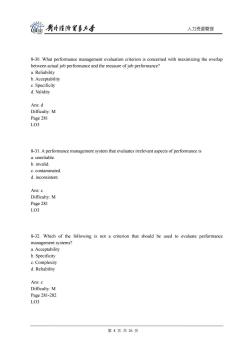
裢贵华经将贸墨去号 人力资源管理 8-30.What performance management evaluation criterion is concerned with maximizing the overlap between actual job performance and the measure of job performance? a.Reliability b.Acceptability c.Specificity d.Validity Ans:d Difficulty:M Page 281 L03 8-31.A performance management system that evaluates irrelevant aspects of performance is a.unreliable. b.invalid. c.contaminated d.inconsistent. Ans:c Difficulty:M Page 281 L03 8-32.Which of the following is not a criterion that should be used to evaluate performance management systems? a.Acceptability b.Specificity c.Complexity d.Reliability Ans:c Difficulty:M Page281-282 L03 第8页共26页
人力资源管理 8-30. What performance management evaluation criterion is concerned with maximizing the overlap between actual job performance and the measure of job performance? a. Reliability b. Acceptability c. Specificity d. Validity Ans: d Difficulty: M Page 281 LO3 8-31. A performance management system that evaluates irrelevant aspects of performance is a. unreliable. b. invalid. c. contaminated. d. inconsistent. Ans: c Difficulty: M Page 281 LO3 8-32. Which of the following is not a criterion that should be used to evaluate performance management systems? a. Acceptability b. Specificity c. Complexity d. Reliability Ans: c Difficulty: M Page 281-282 LO3 第 8 页 共 26 页
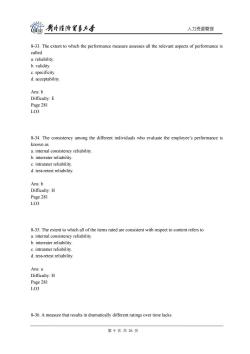
渊好经舍氨多大景 人力资源管理 8-33.The extent to which the performance measure assesses all the relevant aspects of performance is called a.reliability. b.validity. c.specificity. d.acceptability. Ans:b Difficulty:E Page 281 L03 8-34.The consistency among the different individuals who evaluate the employee's performance is known as a.internal consistency reliability. b.interrater reliability c.intrarater reliability. d.test-retest reliability. Ans:b Difficulty:H Page 281 LO3 8-35.The extent to which all of the items rated are consistent with respect to content refers to a.internal consistency reliability. b.interrater reliability c.intrarater reliability. d.test-retest reliability. Ans:a Difficulty:H Page 281 L03 8-36.A measure that results in dramatically different ratings over time lacks 第9页共26页
人力资源管理 8-33. The extent to which the performance measure assesses all the relevant aspects of performance is called a. reliability. b. validity. c. specificity. d. acceptability. Ans: b Difficulty: E Page 281 LO3 8-34. The consistency among the different individuals who evaluate the employee’s performance is known as a. internal consistency reliability. b. interrater reliability. c. intrarater reliability. d. test-retest reliability. Ans: b Difficulty: H Page 281 LO3 8-35. The extent to which all of the items rated are consistent with respect to content refers to a. internal consistency reliability. b. interrater reliability. c. intrarater reliability. d. test-retest reliability. Ans: a Difficulty: H Page 281 LO3 8-36. A measure that results in dramatically different ratings over time lacks 第 9 页 共 26 页
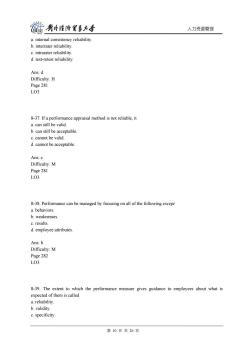
链男4经降贸多大是 人力资源管理 a.internal consistency reliability b.interrater reliability c.intrarater reliability. d.test-retest reliability. Ans:d Difficulty:H Page 281 LO3 8-37.If a performance appraisal method is not reliable,it a.can still be valid. b.can still be acceptable. c.cannot be valid. d.cannot be acceptable. Ans:c Difficulty:M Page 281 LO3 8-38.Performance can be managed by focusing on all of the following except a.behaviors. b.weaknesses. c.results. d.employee attributes. Ans:b Difficulty:M Page 282 LO3 8-39.The extent to which the performance measure gives guidance to employees about what is expected of them is called a.reliability. b.validity. c.specificity. 第10页共26页
人力资源管理 a. internal consistency reliability. b. interrater reliability. c. intrarater reliability. d. test-retest reliability. Ans: d Difficulty: H Page 281 LO3 8-37. If a performance appraisal method is not reliable, it a. can still be valid. b. can still be acceptable. c. cannot be valid. d. cannot be acceptable. Ans: c Difficulty: M Page 281 LO3 8-38. Performance can be managed by focusing on all of the following except a. behaviors. b. weaknesses. c. results. d. employee attributes. Ans: b Difficulty: M Page 282 LO3 8-39. The extent to which the performance measure gives guidance to employees about what is expected of them is called a. reliability. b. validity. c. specificity. 第 10 页 共 26 页
按次数下载不扣除下载券;
注册用户24小时内重复下载只扣除一次;
顺序:VIP每日次数-->可用次数-->下载券;
- 对外经贸大学:《人力资源管理 Human Resource Management》课程教学资源(作业)Chapter 5 Personnel Selection and Placement.pdf
- 对外经贸大学:《人力资源管理 Human Resource Management》课程教学资源(作业)Chapter 4 Human Resource Planning.pdf
- 对外经贸大学:《人力资源管理 Human Resource Management》课程教学资源(作业)Chapter 3 The Analysis and Design of Work.pdf
- 对外经贸大学:《人力资源管理 Human Resource Management》课程教学资源(作业)Chapter 2 Strategic Human Resource Management.pdf
- 对外经贸大学:《人力资源管理 Human Resource Management》课程教学资源(作业)Chapter 1 Human Resource Management:Gaining a Competitive Advantage.pdf
- 对外经济贸易大学:《营销学原理》课程教学资源(教学方案,英文).pdf
- 对外经济贸易大学:《营销学原理》课程教学资源(试题)1997-1998期末考试试卷二(英文,含答案).pdf
- 对外经济贸易大学:《营销学原理》课程教学资源(试题)2001-2002期末考试试卷一(英文,含答案).pdf
- 对外经济贸易大学:《营销学原理》课程教学大纲 Principles of Marketing(英文).pdf
- 对外经贸大学:《国际企业管理 International business management》课程教学资源(授课教案)第五篇 走出去战略 第十章 中国企业跨国经营战略.pdf
- 对外经贸大学:《国际企业管理 International business management》课程教学资源(授课教案)第四篇 跨国经营战略篇 第九章 跨国企业的资源寻求战略.pdf
- 对外经贸大学:《国际企业管理 International business management》课程教学资源(授课教案)第四篇 跨国经营战略篇 第八章 跨国企业营销战略.pdf
- 对外经贸大学:《国际企业管理 International business management》课程教学资源(授课教案)第四篇 跨国经营战略篇 第七章 获得全球竞争优势.pdf
- 对外经贸大学:《国际企业管理 International business management》课程教学资源(授课教案)第三篇 跨国进入战略 第六章 跨国进入方式.pdf
- 对外经贸大学:《国际企业管理 International business management》课程教学资源(授课教案)第三篇 跨国进入战略 第五章 跨国进入分析.pdf
- 对外经贸大学:《国际企业管理 International business management》课程教学资源(授课教案)第四章 基于发展中国家和地区的跨国经营理论.pdf
- 对外经贸大学:《国际企业管理 International business management》课程教学资源(授课教案)第二篇 跨国经营理论 第三章 基于外国直接投资(FDI)的跨国经营理论.pdf
- 对外经贸大学:《国际企业管理 International business management》课程教学资源(授课教案)第二篇 跨国经营理论 Part Two International Business Theories and Practices(第二章 基于贸易的跨国经营理论、第三章 基于外国直接投资(FDI)的跨国经营理论).pdf
- 对外经贸大学:《国际企业管理 International business management》课程教学资源(授课教案)第一篇 导论 第一章 跨国公司与跨国经营.pdf
- 对外经贸大学:《国际企业管理 International business management》课程教学资源(案例)Case6 Jollibee Foods Corporation 快乐蜂(Jollibee)快餐连锁店的国际扩张历程.pdf
- 对外经贸大学:《人力资源管理 Human Resource Management》课程教学资源(作业)Chapter 7 Training.pdf
- 对外经贸大学:《人力资源管理 Human Resource Management》课程教学资源(作业)Chapter 8 Pay Structure Decisions.pdf
- 对外经贸大学:《人力资源管理 Human Resource Management》课程教学资源(作业)Chapter 9 Recognizing Employee Contributions with Pay.pdf
- 对外经贸大学:《人力资源管理 Human Resource Management》课程教学资源(作业)Chapter 10 Managing Human Resources Globally.pdf
- 对外经贸大学:《人力资源管理 Human Resource Management》课程教学资源(授课教案)第一章 人力资源管理——赢得竞争优势.pdf
- 对外经贸大学:《人力资源管理 Human Resource Management》课程教学资源(授课教案)第二章 战略性人力资源管理 Strategic HR Management.pdf
- 对外经贸大学:《人力资源管理 Human Resource Management》课程教学资源(授课教案)第三章 工作分析与设计 The Analysis and Design of Work.pdf
- 对外经贸大学:《人力资源管理 Human Resource Management》课程教学资源(授课教案)第四章 人力资源规划.pdf
- 对外经贸大学:《人力资源管理 Human Resource Management》课程教学资源(授课教案)第五章 人员招聘与安置 Personnel Selection & Placement.pdf
- 对外经贸大学:《人力资源管理 Human Resource Management》课程教学资源(授课教案)第六章 绩效考核 Appraising and Managing Performance.pdf
- 对外经贸大学:《人力资源管理 Human Resource Management》课程教学资源(授课教案)第七章 员工培训与发展 Training and Developing Employees.pdf
- 对外经贸大学:《人力资源管理 Human Resource Management》课程教学资源(授课教案)第八章 薪酬方案 Establishing Pay Plans.pdf
- 对外经贸大学:《人力资源管理 Human Resource Management》课程教学资源(授课教案)第九章 绩效奖励与认可 Recognizing Employee Contributions with Pay.pdf
- 对外经贸大学:《人力资源管理 Human Resource Management》课程教学资源(授课教案)第十章 全球化的人力资源管理 Managing Global Human Resources.pdf
- 对外经济贸易大学:《管理信息系统》课程教学资源(作业)各章习题集.pdf
- 对外经济贸易大学:《管理信息系统》课程教学资源(案例)江铃国际管理信息系统案例分析.pdf
- 对外经济贸易大学:《管理信息系统》课程教学资源(试题)期末考试试卷(A卷).pdf
- 对外经济贸易大学:《管理信息系统》课程教学资源(试题)期末考试试卷(B卷).pdf
- 对外经济贸易大学:《管理信息系统》课程教学资源(复习要点).pdf
- 对外经济贸易大学:《管理信息系统》课程教学资源(实验指导)实验一 产品销售管理(Access数据库和表的使用).pdf
